2023 TOYOTA 86 lock
[x] Cancel search: lockPage 26 of 449
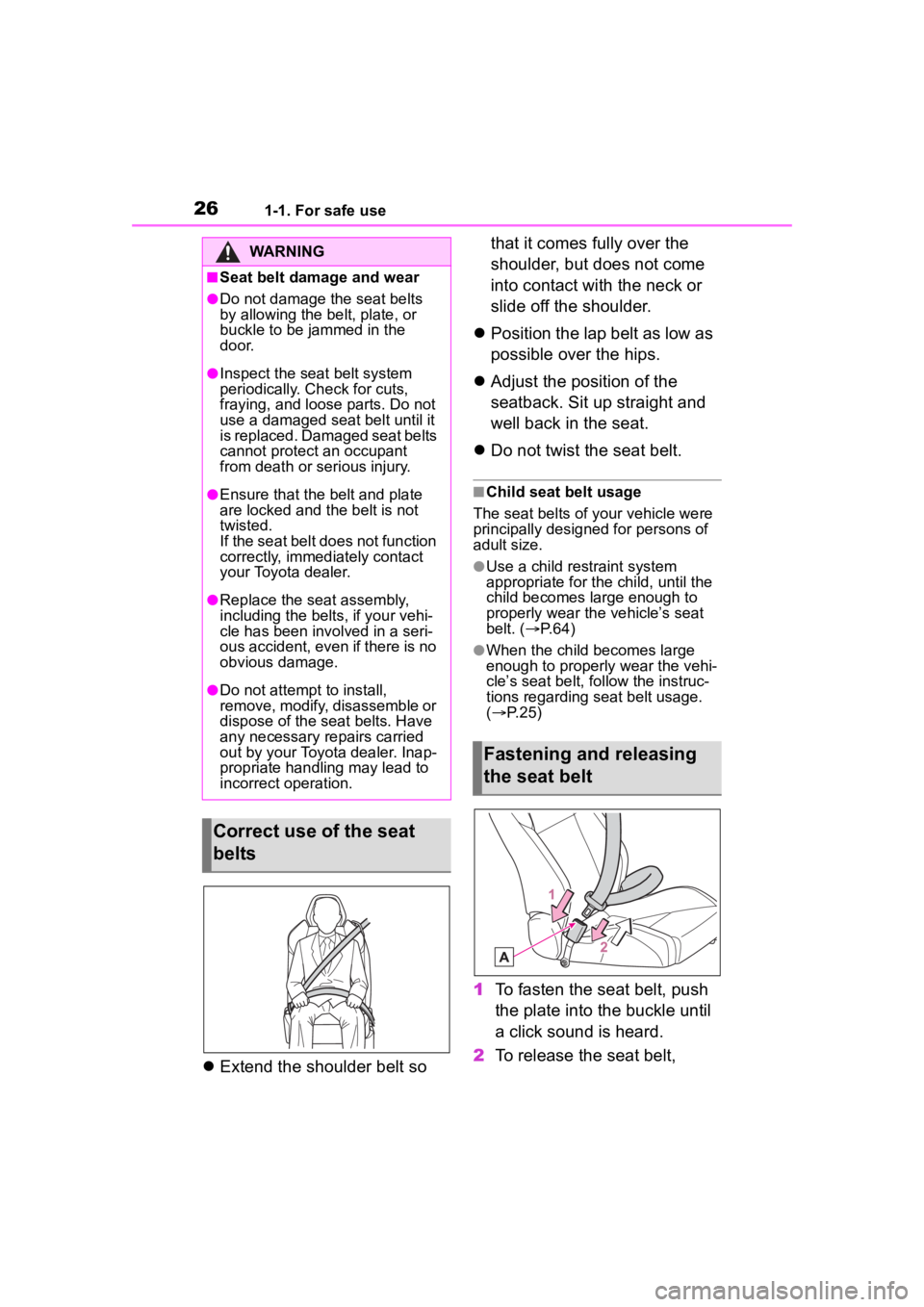
261-1. For safe use
Extend the shoulder belt so that it comes fully over the
shoulder, but does not come
into contact with the neck or
slide off the shoulder.
Position the lap belt as low as
possible over the hips.
Adjust the position of the
seatback. Sit up straight and
well back in the seat.
Do not twist the seat belt.
■Child seat belt usage
The seat belts of your vehicle were
principally designed for persons of
adult size.
●Use a child restraint system
appropriate for the child, until the
child becomes large enough to
properly wear the vehicle’s seat
belt. ( P. 6 4 )
●When the child becomes large
enough to properl y wear the vehi-
cle’s seat belt, follow the instruc-
tions regarding seat belt usage.
( P. 2 5 )
1 To fasten the seat belt, push
the plate into the buckle until
a click sound is heard.
2 To release the seat belt,
WARNING
■Seat belt damage and wear
●Do not damage the seat belts
by allowing the belt, plate, or
buckle to be jammed in the
door.
●Inspect the seat belt system
periodically. Check for cuts,
fraying, and loose parts. Do not
use a damaged sea t belt until it
is replaced. Damaged seat belts
cannot protect an occupant
from death or serious injury.
●Ensure that the belt and plate
are locked and the belt is not
twisted.
If the seat belt does not function
correctly, immediately contact
your Toyota dealer.
●Replace the seat assembly,
including the belts, if your vehi-
cle has been involved in a seri-
ous accident, even if there is no
obvious damage.
●Do not attempt to install,
remove, modify, disassemble or
dispose of the seat belts. Have
any necessary repairs carried
out by your Toyota dealer. Inap-
propriate handling may lead to
incorrect operation.
Correct use of the seat
belts
Fastening and releasing
the seat belt
Page 27 of 449
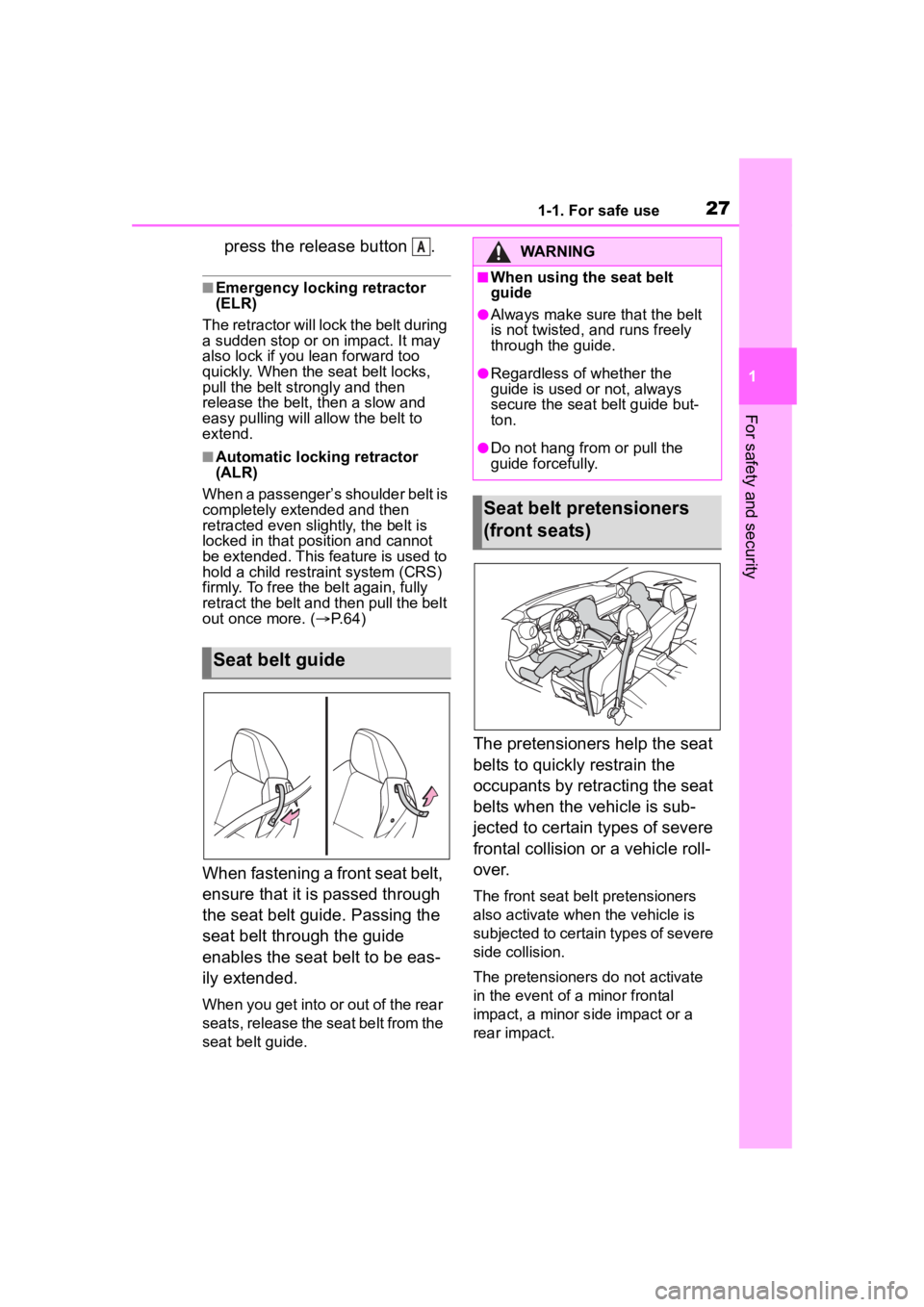
271-1. For safe use
1
For safety and security
press the release button .
■Emergency locking retractor
(ELR)
The retractor will lock the belt during
a sudden stop or on impact. It may
also lock if you lean forward too
quickly. When the seat belt locks,
pull the belt str ongly and then
release the belt, then a slow and
easy pulling will allow the belt to
extend.
■Automatic locking retractor
(ALR)
When a passenger’s shoulder belt is
completely extended and then
retracted even slightly, the belt is
locked in that position and cannot
be extended. This feature is used to
hold a child restraint system (CRS)
firmly. To free the belt again, fully
retract the belt and then pull the belt
out once more. ( P. 6 4 )
When fastening a front seat belt,
ensure that it is passed through
the seat belt guide. Passing the
seat belt through the guide
enables the seat belt to be eas-
ily extended.
When you get into or out of the rear
seats, release the seat belt from the
seat belt guide.
The pretensioners help the seat
belts to quickly restrain the
occupants by retracting the seat
belts when the vehicle is sub-
jected to certain types of severe
frontal collision or a vehicle roll-
over.
The front seat belt pretensioners
also activate when the vehicle is
subjected to certain types of severe
side collision.
The pretensioners do not activate
in the event of a minor frontal
impact, a minor s ide impact or a
rear impact.
Seat belt guide
AWARNING
■When using the seat belt
guide
●Always make sure that the belt
is not twisted, and runs freely
through the guide.
●Regardless of whether the
guide is used or not, always
secure the seat belt guide but-
ton.
●Do not hang fr om or pull the
guide forcefully.
Seat belt pretensioners
(front seats)
Page 45 of 449
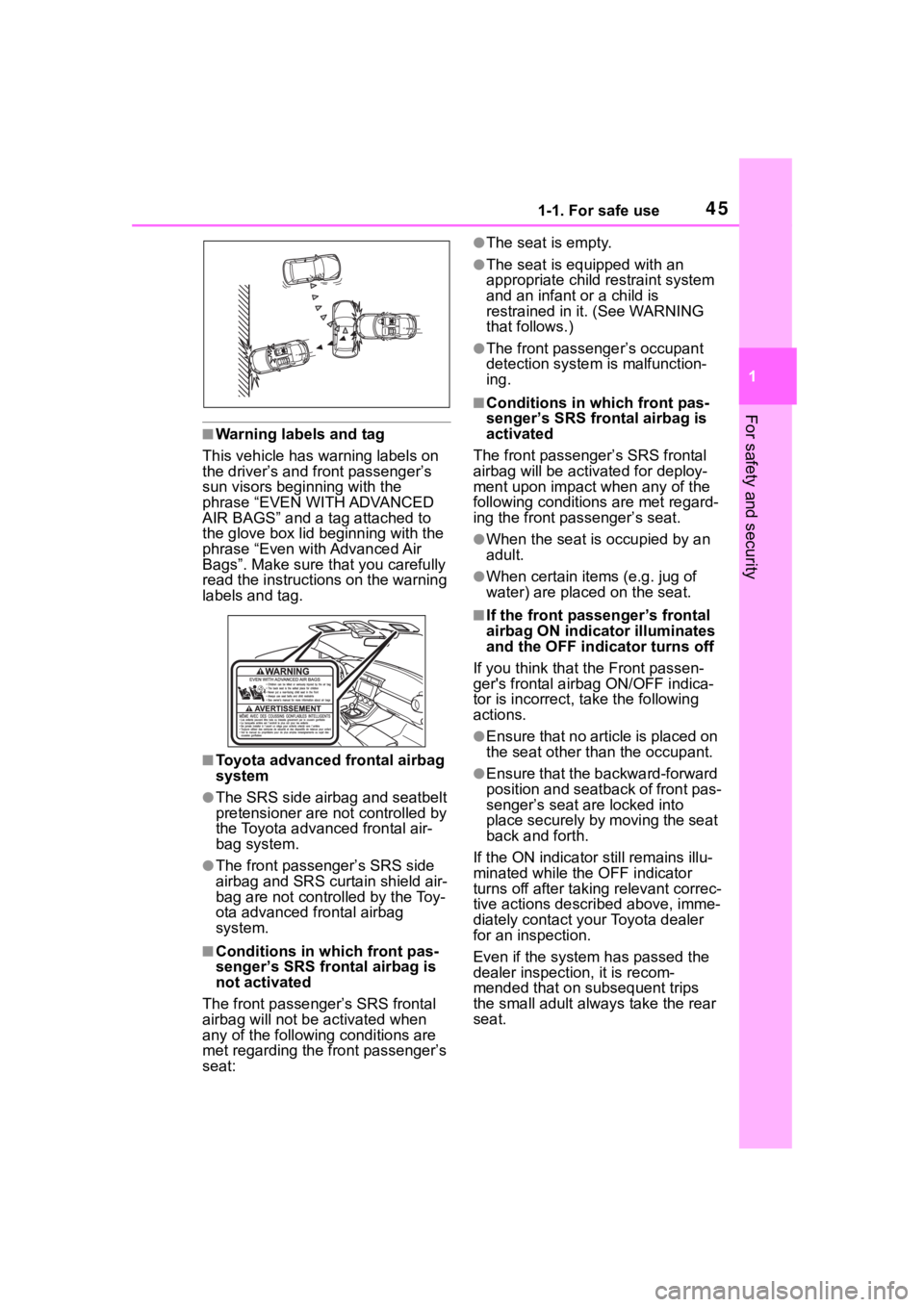
451-1. For safe use
1
For safety and security
■Warning labels and tag
This vehicle has warning labels on
the driver’s and front passenger’s
sun visors beginning with the
phrase “EVEN WITH ADVANCED
AIR BAGS” and a tag attached to
the glove box lid beginning with the
phrase “Even with Advanced Air
Bags”. Make sure that you carefully
read the instructions on the warning
labels and tag.
■Toyota advanced frontal airbag
system
●The SRS side airbag and seatbelt
pretensioner are not controlled by
the Toyota advanced frontal air-
bag system.
●The front passenger’s SRS side
airbag and SRS curtain shield air-
bag are not controlled by the Toy-
ota advanced frontal airbag
system.
■Conditions in which front pas-
senger’s SRS frontal airbag is
not activated
The front passenger’s SRS frontal
airbag will not be activated when
any of the following conditions are
met regarding the front passenger’s
seat:
●The seat is empty.
●The seat is equipped with an
appropriate child restraint system
and an infant or a child is
restrained in i t. (See WARNING
that follows.)
●The front passenger’s occupant
detection system is malfunction-
ing.
■Conditions in which front pas-
senger’s SRS frontal airbag is
activated
The front passenge r’s SRS frontal
airbag will be activ ated for deploy-
ment upon impact when any of the
following conditions are met regard-
ing the front passenger’s seat.
●When the seat is occupied by an
adult.
●When certain items (e.g. jug of
water) are plac ed on the seat.
■If the front passenger’s frontal
airbag ON indicator illuminates
and the OFF indicator turns off
If you think that the Front passen-
ger's frontal airb ag ON/OFF indica-
tor is incorrect, take the following
actions.
●Ensure that no article is placed on
the seat other than the occupant.
●Ensure that the backward-forward
position and seatback of front pas-
senger’s seat are locked into
place securely by moving the seat
back and forth.
If the ON indicator still remains illu-
minated while the OFF indicator
turns off after taking relevant correc-
tive actions descr ibed above, imme-
diately contact your Toyota dealer
for an inspection.
Even if the system has passed the
dealer inspection, it is recom-
mended that on subsequent trips
the small adult alwa ys take the rear
seat.
Page 48 of 449
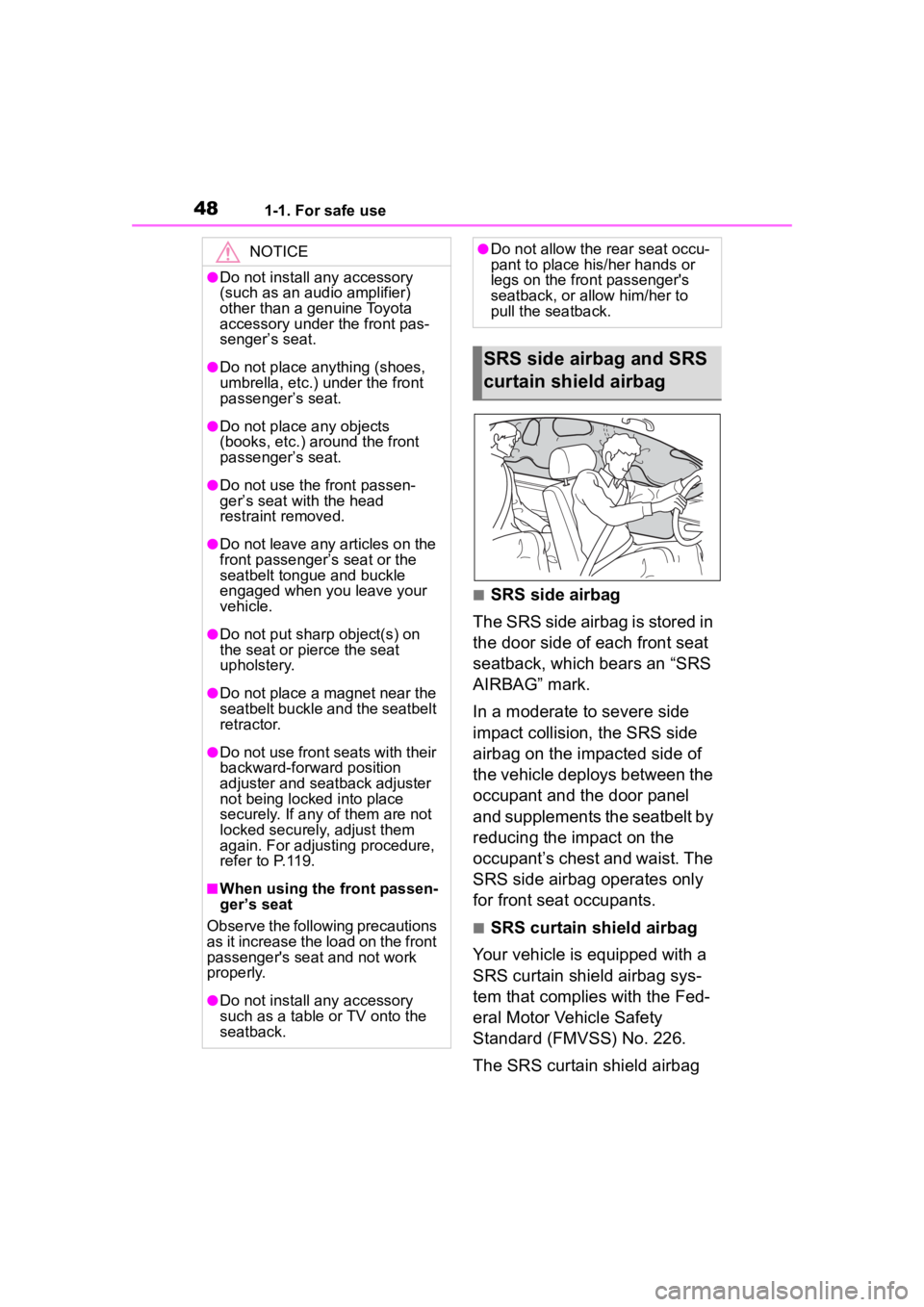
481-1. For safe use
■SRS side airbag
The SRS side airbag is stored in
the door side of each front seat
seatback, which bears an “SRS
AIRBAG” mark.
In a moderate to severe side
impact collision, the SRS side
airbag on the impacted side of
the vehicle deploys between the
occupant and the door panel
and supplements the seatbelt by
reducing the impact on the
occupant’s chest and waist. The
SRS side airbag operates only
for front seat occupants.
■SRS curtain shield airbag
Your vehicle is equipped with a
SRS curtain shield airbag sys-
tem that complies with the Fed-
eral Motor Vehicle Safety
Standard (FMVSS) No. 226.
The SRS curtain shield airbag
NOTICE
●Do not install any accessory
(such as an audio amplifier)
other than a genuine Toyota
accessory under the front pas-
senger’s seat.
●Do not place anything (shoes,
umbrella, etc.) under the front
passenger’s seat.
●Do not place any objects
(books, etc.) around the front
passenger’s seat.
●Do not use the front passen-
ger’s seat with the head
restraint removed.
●Do not leave any articles on the
front passenger’ s seat or the
seatbelt tongue and buckle
engaged when you leave your
vehicle.
●Do not put sharp object(s) on
the seat or pierce the seat
upholstery.
●Do not place a magnet near the
seatbelt buckle and the seatbelt
retractor.
●Do not use front seats with their
backward-forward position
adjuster and seatback adjuster
not being locked into place
securely. If any of them are not
locked securely, adjust them
again. For adjusting procedure,
refer to P.119.
■When using the front passen-
ger’s seat
Observe the following precautions
as it increase the load on the front
passenger's seat and not work
properly.
●Do not install any accessory
such as a table or TV onto the
seatback.
●Do not allow the rear seat occu-
pant to place his/her hands or
legs on the front passenger's
seatback, or allow him/her to
pull the seatback.
SRS side airbag and SRS
curtain shield airbag
Page 63 of 449

631-2. Child safety
1
For safety and security
1-2.Child safety
Riding with children
Observe the following pre-
cautions when children are
in the vehicle.
Use a child restraint system
appropriate for the child,
until the child becomes
large enough to properly
wear the vehicle’s seat belt.
It is recommended that chil-
dren sit in the rear seats to
avoid accidental contact
with the shift lever, wiper
switch, etc.
Use the window lock switch
to avoid children operating
the power window acciden-
tally. ( P.130)
Do not let small children
operate equipment which
may catch or pinch body
parts, such as the power
window, hood, trunk, seats
etc.
WARNING
■When children are in the vehi-
cle
Never leave children unattended
in the vehicle, and never allow
children to have or use the key.
Children may be able to start the
vehicle or shift the vehicle into
neutral. There is also a danger
that children ma y injure them-
selves by playing with the win-
dows or other features of the
vehicle. In addition, heat build-up
or extremely cold temperatures
inside the vehicle can be fatal to
children.
Page 67 of 449
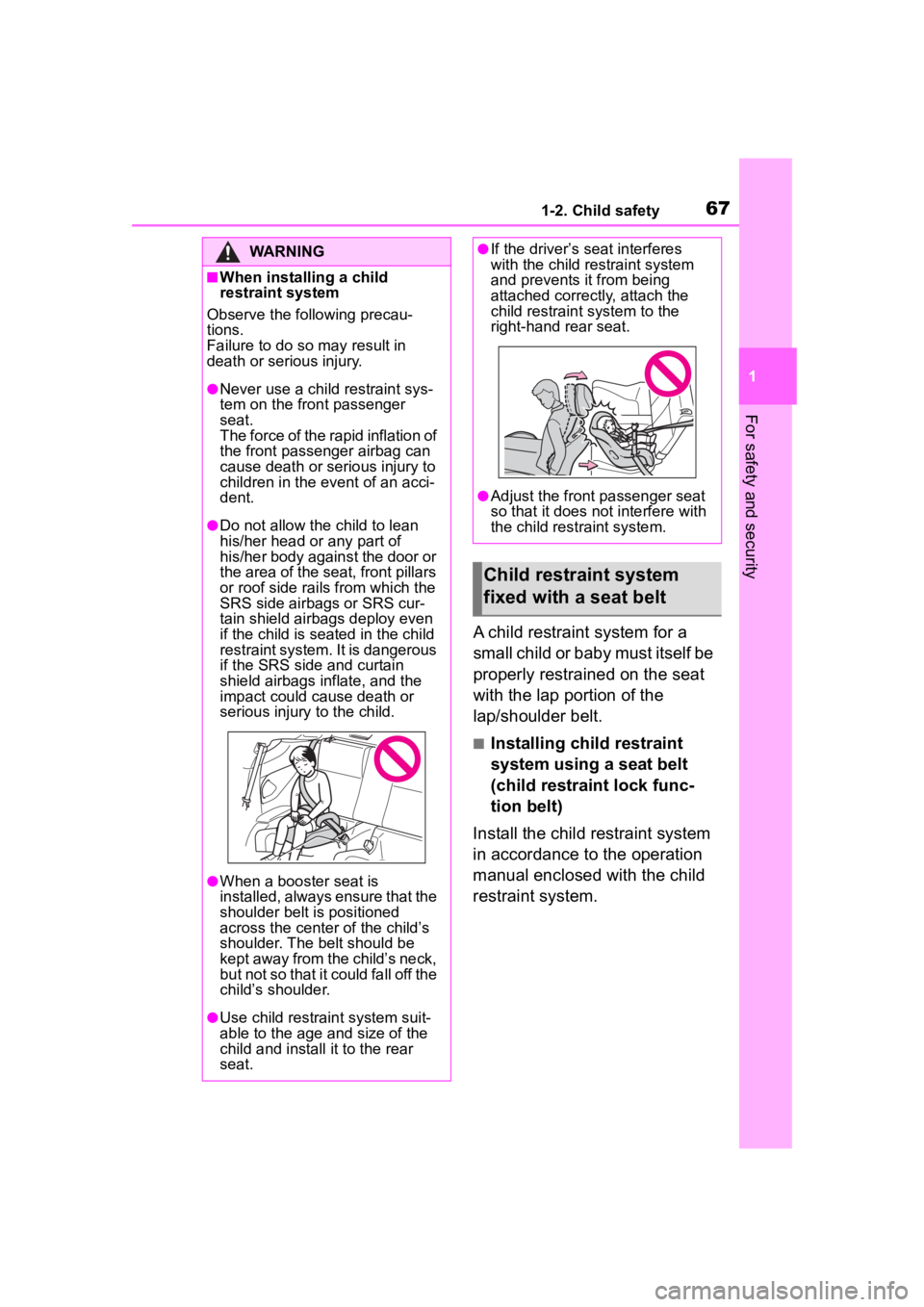
671-2. Child safety
1
For safety and security
A child restraint system for a
small child or baby must itself be
properly restrained on the seat
with the lap portion of the
lap/shoulder belt.
■Installing child restraint
system using a seat belt
(child restraint lock func-
tion belt)
Install the child restraint system
in accordance to the operation
manual enclosed with the child
restraint system.
WARNING
■When installing a child
restraint system
Observe the following precau-
tions.
Failure to do so m ay result in
death or serious injury.
●Never use a child restraint sys-
tem on the front passenger
seat.
The force of the rapid inflation of
the front passenger airbag can
cause death or serious injury to
children in the event of an acci-
dent.
●Do not allow the child to lean
his/her head or any part of
his/her body against the door or
the area of the seat, front pillars
or roof side rails from which the
SRS side airbags or SRS cur-
tain shield airbags deploy even
if the child is seated in the child
restraint system. It is dangerous
if the SRS side and curtain
shield airbags inflate, and the
impact could cause death or
serious injury to the child.
●When a booster seat is
installed, always ensure that the
shoulder belt is positioned
across the center of the child’s
shoulder. The belt should be
kept away from the child’s neck,
but not so that it could fall off the
child’s shoulder.
●Use child restraint system suit-
able to the age and size of the
child and install it to the rear
seat.
●If the driver’s seat interferes
with the child restraint system
and prevents it from being
attached correct ly, attach the
child restraint system to the
right-hand rear seat.
●Adjust the front passenger seat
so that it does not interfere with
the child restraint system.
Child restraint system
fixed with a seat belt
Page 68 of 449

681-2. Child safety
■Rear-facingInfant
seat/convertible seat
1 Place the child restraint sys-
tem on the rear seat facing
the rear of the vehicle.
2 Run the seat belt through the
child restraint system and
insert the plate into the
buckle. Make sure that the
belt is not twisted.
3 Fully extend the shoulder belt
and allow it to retract to put it
in lock mode. In lock mode,
the belt cannot be extended. 4
While pushing the child
restraint system down into
the rear seat, allow the shoul-
der belt to retract until the
child restraint system is
securely in place.
After the shoulder belt has
retracted to a poi nt where there is
no slack in the belt, pull the belt to
check that it cannot be extended.
5 After installing the child
restraint system, rock it back
and forth to ensure that it is
installed securely. ( P.70)
■Forward-facing Convert-
ible seat
1 Place the child restraint sys-
tem on the seat facing the
front of the vehicle.
2 Run the seat belt through the
child restraint system and
insert the plate into the
Page 69 of 449
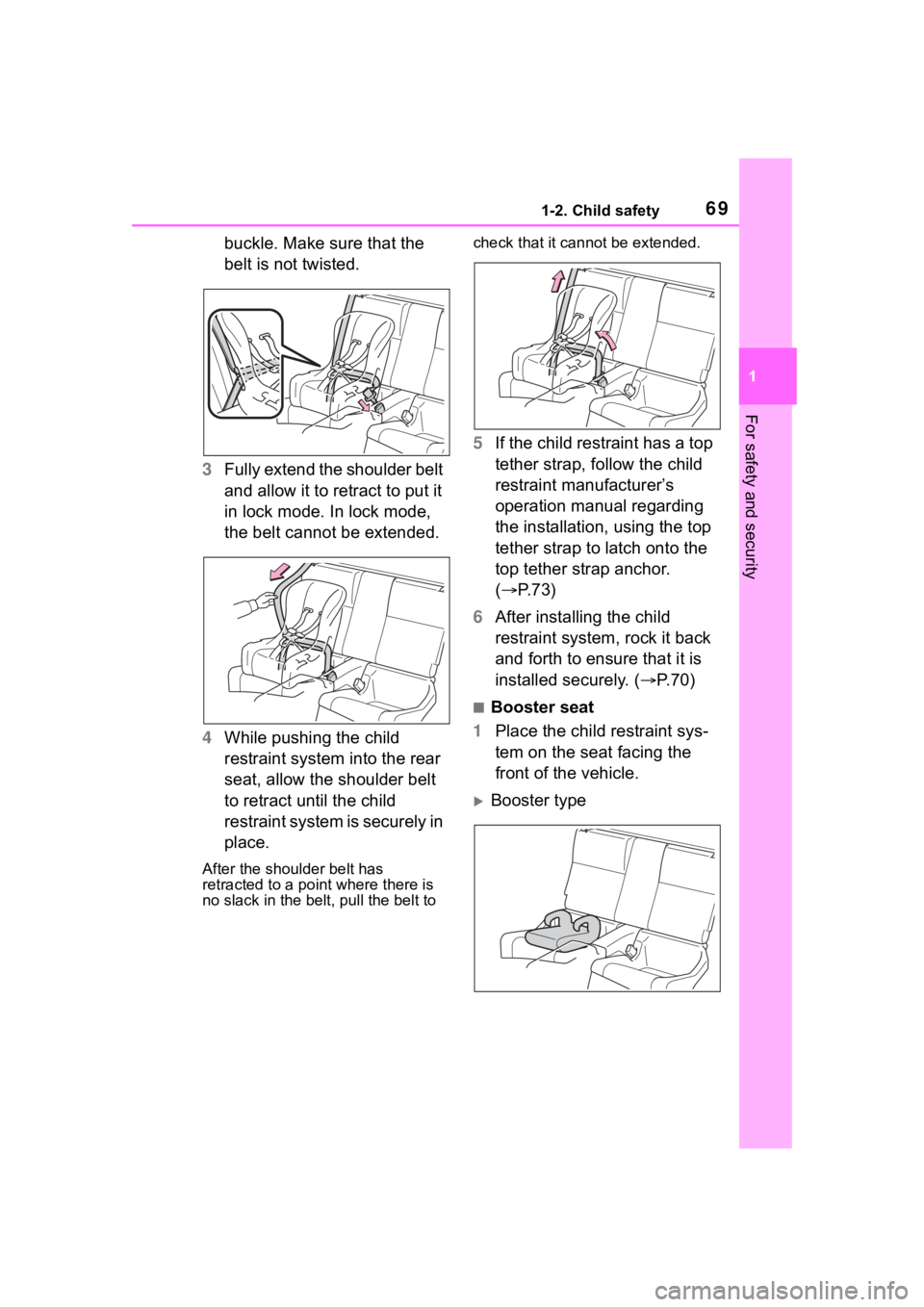
691-2. Child safety
1
For safety and security
buckle. Make sure that the
belt is not twisted.
3 Fully extend the shoulder belt
and allow it to retract to put it
in lock mode. In lock mode,
the belt cannot be extended.
4 While pushing the child
restraint system into the rear
seat, allow the shoulder belt
to retract until the child
restraint system is securely in
place.
After the shoulder belt has
retracted to a point where there is
no slack in the belt, pull the belt to check that it cannot be extended.
5
If the child restraint has a top
tether strap, follow the child
restraint manufacturer’s
operation manual regarding
the installation, using the top
tether strap to latch onto the
top tether strap anchor.
( P.73)
6 After installing the child
restraint system, rock it back
and forth to ensure that it is
installed securely. ( P.70)
■Booster seat
1 Place the child restraint sys-
tem on the seat facing the
front of the vehicle.
Booster type